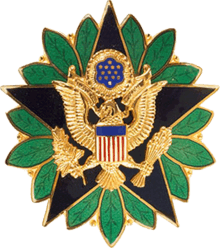William Wilson Quinn
Lieutenant General William Wilson "Buffalo Bill" Quinn (November 1, 1907 – September 11, 2000)[1] [2] was a United States Army officer, who served in intelligence during World War II. Born in Crisfield, Somerset, Maryland and a 1933 graduate of West Point, Quinn retired as a lieutenant general on March 1, 1966 as the commanding general of the Seventh United States Army. He died in Washington, DC at Walter Reed Army Hospital at 92 years old.[3]
Education
Quinn graduated from Crisfield High with the class of 1925 and then from United States Military Academy with the class of 1933, and in 1938 attended United States Army Infantry School. In 1942 he graduated from Command and General Staff College. In August 1947 he graduated from the National War College.
Commands Held
From 1933–1935 at Fort McKinley Quinn was the commanding officer of Company L. 1935–1936 General Quinn was assigned to Company D and then from 1936–1938 assigned to the Headquarters Company of the 31st Infantry. In 1940 he was the Command of Headquarters Company of the 4th Infantry Division, and the Commanding Officers of Company D, 8th Infantry Division. In July 1942 he became the United States Chief of Staff of the G-2 IV Army Corps. In 1949 Quinn was the Commanding Officer of the Far East 3rd Battalion, 34th Infantry Division. In April 1949 he became Chief of the Training Sub-section, I Corps. In January 1950 he became the Assistant Chief of Staff of the G-3 I Corps from February to March. In January 1951, Quinn was the Commanding Officer of the 17th Infantry, 7th Division in Korea. In 1952 Quinn became the Deputy Chief of Staff of the Pentagon and Deputy Chief of Staff for Planning Coordination of the Office of Chief of Staff, and then eventually became the Chief of Staff of the Pentagon. In 1953 Quinn was transferred to Greece and to be the Head of the Army Section, Joint Military Aid Group to Greece. In January 1957 he was the Commanding Officer of the 4th Infantry Division of the Strategic Army Corps at Fort Lewis. In July 1958 he became the Deputy Chief of Staff for the G-2 Intelligence of the United States Army. From 1959–1961, Quinn served as the Army's Chief of Information, and in 1959 he became the Chief of Public Information of the Department of the Army. In 1961 Quinn became the Deputy Director of the Defence Intelligence Agency and promoted to Lieutenant General. From 1964–1966, Quinn was the Commanding General of the United States Army Europe and Seventh United States Army, commonly referred to as 7th Army, in Stuttgart-Vaihingen, Germany. On March 1, 1966 Quinn retired but became Honorary Colonel of the 17th Infantry, The Buffalos. He was chief of operations of the CIA.[4][5][6][7]
World War II
Quinn participated in the Battle of the Bulge, Operation Dragoon and on January 1, 1945 he was part of Operation Northwind.
Korea
Quinn was in Korea from 1951 to 1952 and in August 1951 Quinn was wounded in Korea. While in Korea he won and was awarded the Silver Star, Legion of Merit and the Bronze Star with the "V" Device. He was also in the Battle of Inchon. While he was in Korea he was the commanding Officer of the 17th Infantry Regiment which was part of the 7th Infantry Division (the 17th Infantry was, and still is, nicknamed "the Buffalo's").
Awards and decorations
 Army Staff Identification Badge Army Staff Identification Badge |
| Army Distinguished Service Medal | |
| Silver Star | |
| Legion of Merit with oak leaf cluster | |
| Bronze Star with V Device and oak leaf cluster | |
| Purple Heart | |
| Air Medal with 2 oak leaf clusters | |
| Army Commendation Medal with 2 oak leaf clusters | |
| American Defense Medal | |
| American Campaign Medal | |
| European-African-Middle Eastern Campaign Medal with arrowhead and 5 campaign stars | |
| World War II Victory Medal | |
| Army of Occupation Medal | |
| National Defense Service Medal (Korea) | |
| Korean Service Medal with arrowhead and 5 campaign stars | |
| Vietnam Service Medal | |
| Knight Order of the Legion of Honor, class of Officer (France) | |
| Order of St. George (Third Class) (Russia) | |
| Croix de guerre (France) | |
| Gallantry Cross (Republic of Vietnam) | |
| United Nations Service Medal for Korea | |
| Vietnam Campaign Medal | |
| Republic of Korea Presidential Unit Citation |
Personal
Quinn was married to Sara Bette Williams, who is buried next to him at Arlington National Cemetery. Together they had three children; Quinn has two siblings, Donna, William Jr., and Sally Quinn.
References
- ↑ "William W. Quinn, 92, General and Former Intelligence Officer". The New York Times. Retrieved 16 November 2012.
- ↑ Anderson, John. "Gen William Wilson Quinn". Find A Grave. Retrieved 16 November 2012.
- ↑ http://www.aegis-consulting.com/quinn/
- ↑ "William W. Quinn, 92, General and Former Intelligence Officer". New York Times. Retrieved 24 December 2012.
- ↑ "Lt. Gen. William W. Quinn; Helped Established CIA". Los Angeles Times. Retrieved 24 December 2012.
- ↑ "Mike Goodson: Up to the Challenge". The Gasden Times.
- ↑ "William Wilson Quinn". Arlington National Cemetery.
- ↑ Quinn image JBLM
- ↑ http://www.tititudorancea.com/z/croix_de_guerre.htm
- ↑ http://www.aegis-consulting.com/quinn/
External links
- http://www.arlingtoncemetery.net/wwquinn.htm
- http://findarticles.com/p/articles/mi_m0IBS/is_1_29/ai_97822107/
- http://www.nytimes.com/2000/09/12/us/william-w-quinn-92-general-and-former-intelligence-officer.html
- http://www.aegis-consulting.com/quinn/
- http://www.google.com/search?client=safari&rls=en&q=Lietunant+General+William+Wilson+Quinn&ie=UTF-8&oe=UTF-8#q=Lieutenant+General+William+Wilson+Quinn&hl=en&client=safari&pwst=1&rls=en&prmd=ivnso&ei=RCwJTsWCMcmutwfQweR_&start=10&sa=N&bav=on.2,or.r_gc.r_pw.&fp=5bfb3118ef20f74c&biw=1151&bih=622
- http://www.c-spanvideo.org/videoLibrary/clip.php?appid=596804011
| Government offices | ||
|---|---|---|
| Preceded by John Magruder |
Director of the Strategic Services Unit 1946–1947 |
Position abolished |
